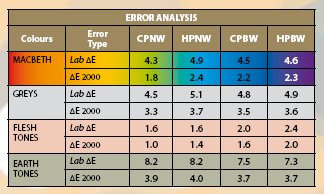articles/Paper/epsonhotcold-page1
Great Paper Chase Epson Hot ande Cold Pressed Paper - part 1 of 1 2 3
by Mike McNamee Published 01/02/2010

Epson recently introduced four heavyweight art papers which have also been added to their accredited list in the Digi Graphie series and are intended for the creation of high-quality, high-value giclee prints.
They carry the classification of either 'hot pressed' or 'cold pressed', a term that should not be confused with the lamination company Hot Press. Hot pressing is a traditional paper-finishing method in which the paper is sandwiched between pre-heated metal plates and then the assembly passed through heavy metal rollers. This results in a smoother surface than regular callendering (ie going straight through polished rollers). By comparison, cold-pressed materials are passed through a roller with a textured surface so as toleave a characteristic 'tooth' or texture on the paper.
Testing
We obtained icc profiles and instructions from http://www.epson.com/cgi-bin/Store/jsp/Pro/ICCProfilesAll. do?BV_UseBVCookie=yes

It's a bit of a typing marathon but worth the effort, as you will see. For each of the four papers, two profiles are provided for use at 2880 or 1440 dpi, for the chosen Epson 3800. In all cases we followed the advice and used 'Ultra Smooth Fine Art Paper' for our media setting. For the record we also used BPC ON and High Speed OFF. For simplicity we have collated the baseline data into a single table.
Cold Pressed Natural White
Amongst its peer group, this surface has a relatively light tooth, it is in every way a classic-looking watercolour surface. It is, however, quite a bright paper and we broke from our normal protocol and made a print first. An awesome print it was too; and so we hurried back to collect the statistics from our colour audit process. Again we were surprised when this delivered an error so low (1.73ΔE₀₀) that we immediately checked with another spectro! This one reported an average error of 1.84ΔE₀₀ so there it was, a new record by miles, and right out of the box with a generic profile.
The statistics are worth dwelling upon. They are shown in the table. The weakest reproduction was the deep blue a quite usual finding but not quite so normal with a cool paper. The flesh tones delivered an error of just 0.94ΔE₀₀. The residual errors around the gamut were mainly due to the final Dmax, because, although it is low for this class of paper, it can never achieve truly deep tones when the limiting luminance is around 17% compared with 5% for a gloss paper. The measured Dmax was 1.62 and the profile brought the blacks down evenly to a terminal value around 20 RGB points. The highlights clogged a little early at 248 points. The Granger Chart was one of the smoothest we have seen.
In case you have not got the message, we were rather impressed with this paper and its profiles!
You are currently on page 1
- Great Paper Chase Epson Hot ande Cold Pressed Paper page 1
- Great Paper Chase Epson Hot ande Cold Pressed Paper page 2
- Great Paper Chase Epson Hot ande Cold Pressed Paper page 3
1st Published 01/02/2010
last update 09/12/2022 14:53:56
More Paper Articles
There are 29 days to get ready for The Society of Photographers Convention and Trade Show at The Novotel London West, Hammersmith ...
which starts on Wednesday 14th January 2026





